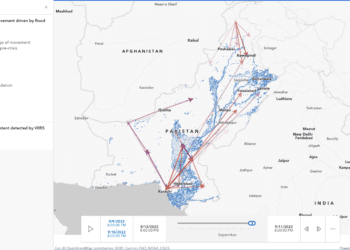Update: Wednesday, January 11, 2022
Extreme rainfall, heavy winds, and flooding has killed at least 14 people in California since Sunday, January 8. As of Tuesday, January 10, tens of thousands of California residents have been given evacuation orders, and more than 150,000 electric customers were without power at this time.
New data reports from CrisisReady show changes in population densities across the areas most affected by the floods. Specific areas of focus include those between Santa Cruz and Monterey (in northern California), and areas between Santa Barbara and Ventura (in southern California).
January 9, 2023 | Santa Cruz – Monterey, Northern California, United States
Key Observations:
- Relatively low levels of population movement were detected in Santa Cruz and Monterey at the time of analysis.
- Among higher population areas, Monterey exhibited a population decline of 8%, and Salinas a decline by 9%.
- It is likely that low levels of movement are attributed to transportation impairment from flooded roads and other obstructions.
January 9, 2023 | Santa Barbara – Ventura, Southern California, United States
Key Observations:
- Despite heavy flooding as of January 9, 2023, the areas between Santa Barbara and Ventura saw minimal changes in population densities and movement.
- There were two significant exceptions to this trend: Montecito saw a decline in population density of 22% and the campus of the University of California Santa Barbara (UCSB) saw an increased density of 22%.
Update: Monday, January 9, 2022
The risk of flooding has increased significantly in northern California, especially in the Sacramento and San Francisco Bay Areas, as heavy rainfall sweeps across the region. Heavy rain could result in rainfall totals as high as 3 to 5 inches near the coast, the National Weather Service reported.
As of Monday, January 9, a reported 132,140 utility customers in the state were without power due to extreme rainfall and high winds. Rainfall is expected to continue on Tuesday, January 10, which may begin to impact Southern counties.
As northern California grapples with these extreme weather conditions, multiple cyclones are making their way towards the western coast of the state, exacerbating the risk of further flooding, power outages, and displacement.
90% of California — which accounts for 34 million residents — are under flood watches as conditions intensify. Evacuation orders have been issued in the unincorporated community of Wilton, located in Sacramento County, as well as in Santa Cruz. Residents in low-lying areas were told they should be prepared to evacuate and move to higher ground.
These extreme weather events come just after a 5.4 magnitude earthquake struck the region on January 1, 2023. Download CrisisReady’s report showing population density changes across northern California after the earthquake here.
